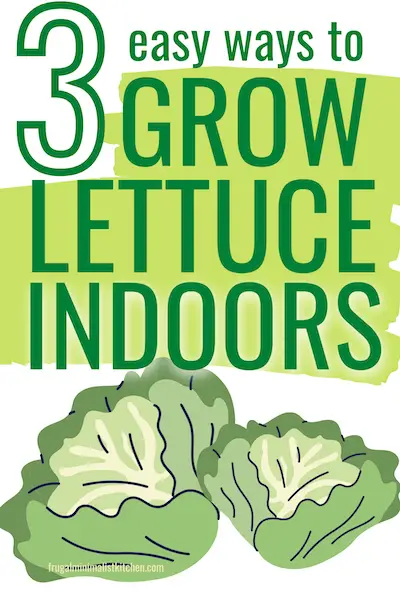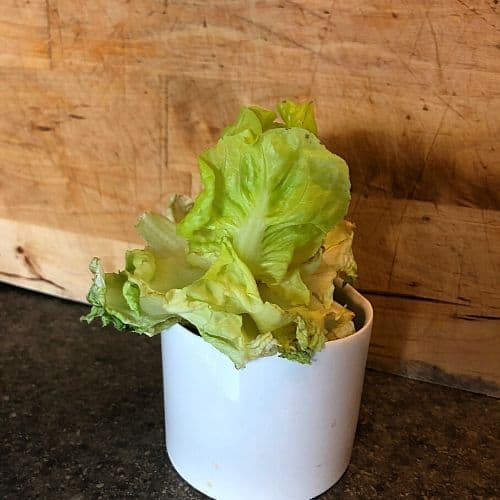Right now we are growing lettuce indoors. Having a little garden has always been my dream but we live in a basement apartment so it’s a bit of a challenge! But it is possible even if you get very little natural light!

The 3 best options for growing lettuce indoors include:
- Regrowing lettuce from scraps
- Keep a living lettuce alive
- Grow microgreens
I go over the simple steps of each method of growing lettuce indoors so you can choose the one that works best for you.
Read through, or head to the option to that you’re most interested in reading by clicking the option below.
But first, get the ebook!
Regrowing Veggies from Scraps ebook gives step-by-step instructions on how to regrow green onions, celery, romaine lettuce, iceberg lettuce, and butter lettuce from just the scraps you’d normally toss! Plus it also includes how to grow microgreens!
All the steps are listed below, but if you want to read it without ads, keep it to reference for later, or print it out, buy a digital copy for only $6 with coupon code READER!
The small fee helps me keep this site running so I can provide you with more great tips. If it’s out of your budget, no worries, you can still get the info you need in the article below.
Get your copy of the Regrow Veggies Ebook now!
1. Growing lettuce from scraps (in water)
Regrowing iceberg lettuce, butter lettuce, or romaine lettuce in water is a very simple process that will provide you with some fresh new salad greens from the stump that you were likely going to throw away!
I love regrowing lettuce from scraps in water because it’s literally free food! You are getting more food for your money compared to if you just composted the ends.
You’ll start to see new green growth appearing within a day or so. The process is very easy and is basically the same for any type of lettuce, as long as the root end is attached. There doesn’t have to be visible roots though.

You can expect a handful of leaves from each stump, but don’t expect a whole new head of lettuce. While this method isn’t going to feed your family, it doesn’t cost anything and helps you get the most out of what you originally paid for your lettuce.
Of all the types of lettuce, I would say growing romaine lettuce in water is the most successful. Butter lettuce works well too. I’ve heard of regrowing iceberg lettuce but haven’t personally tried it myself.
Here are the steps to growing lettuce in water:
Time needed: 10 days.
Easily grow lettuce indoors with only a glass of water! There should be enough to eat after about 10-14 days!
- Cut the lettuce
Cut it so there is at least 1″ (2.5cm) left at the root end. This is normally where the thick, white, bitter part of romaine lettuce starts.
- Put the stump in water
Stand the root end of the lettuce scrap in a small glass that keeps it upright. Add enough water to cover the end, but do not fully submerge the whole cutting. Half way is good.
Check the water and change it every few days. Add more water if the water level drops to make sure the cutting doesn’t dry out. - Give it sunlight
Place the glass in a sunny windowsill or use a grow light.
- Harvest
After about a week or so, you should see new leaves. Harvest them by 10-14 days for the highest yield.
Simply cut the leaves off and use them as you would regular lettuce! The stump will not likely produce any more, so you can compost it now and start the process over with a new one.
How to regrow scallions/green onions from scraps
How to regrow celery from the stalk
Products to help you grow veggies indoors
How to keep green onions fresh for longer
2. How to keep a living lettuce alive
Living lettuces are those that you buy at the store with the root still attached to the bottom. Sometimes they are in water, other times they’re in a small pot of soil!
Living butter lettuces are the most common kind you’ll find, but there are other types as well.
Either way, keep the plant alive so it’s able to continue growing new leaves even as you harvest some of them!
You should be able to keep it alive longer and get more lettuce from it than if you just put the plant in your fridge, but it will not keep producing lettuce forever.
Here are the simple steps to growing living lettuce alive:
- Place the roots in water (optional)
If the roots are bare (without soil), simply find a glass or jar to place the lettuce roots in, then fill with water so the roots are submerged. - Plant in soil (optional)
If the lettuce came with it’s roots in soil, simply plant it in a pot of soil. - Give it light
Place the plant in a sunny windowsill or under a grow light. - Water regularly
If it’s in water, make sure to keep the water fresh and covering the roots.
If it’s in soil, you want the soil to be damp but not soaking wet. Don’t let it dry out. - Harvest
Harvest your lettuce by picking the outer leaves. The rest of the plant will keep growing new leaves!
Note: If you have your living lettuce in water, it will eventually run out of nutrients and start to die. Harvest all the leaves before this happens, or plant it in soil to extend the life.
3. Grow Microgreens
Microgreens are great because they grow really quickly and don’t need as much light or space as growing full heads of lettuce!
You can grow all sorts of microgreens including many types of leaf lettuce, spinach, kale, radish, and more. The process is the same for them all.

To grow microgreens indoors, you will need seeds, soil, and maybe a grow light (if you don’t have natural sunlight).
You will also need a container to plant them in. A shallow, wide container is best. You can buy specially designed seed trays, or just reuse something you already have, like plastic containers from salad greens!
This article has some suggested products for growing microgreens and other veggies indoors.
Here is how to grow microgreens:
- Get a shallow planter of soil
The planter should be at least 2″ (5cm) deep and filled with soil. Use high quality potting soil specially for growing food. - Sprinkle the seeds on the soil
Distribute them like you were adding sprinkles to a cake! Since the plants will be harvested very small, they don’t need to be spaced out like they would need to be if you were trying to grow the full head of lettuce. - Cover the seeds
Add a thin layer of soil on top of the seeds to cover them and gently press down to secure it. - Give them light
Place the tray in a sunny window or under a grow light. If you’re using a window, rotate the tray every few days to make sure they grow evenly. - Water
Water until the soil is saturated, but not soggy. There shouldn’t be water pooling on top or pouring out the drainage holes.
Mist with water daily to keep the soil damp. - Harvest
After the microgreens are about 2″ (5cm) tall you can harvest them. They should be ready by about 10-12 days.
You can cut the leaves off at the soil, or pull the whole plant out. Make sure to rinse them very well before eating to get the dirt off.
Once harvested, the plants will not continue to grow. If you want continuous fresh greens, I’d recommend starting a new tray each week.
FAQ & Troubleshooting
Head lettuces like romaine and butter lettuce will keep growing if you only harvest the outer leaves. Unfortunately lettuce doesn’t produce forever, so it will eventually stop growing after producing new leaves for a while.
Leaf lettuce like microgreens will not continue to grow after being harvested.
Regrowing lettuce from the lettuce stump is similar to regrowing celery from the stalk in that you can regrow it and harvest it only once, or only a little bit at a time.
This differs from regrowing green onions which can be harvested multiple times and will continue to regrow!
If the roots or stump of the lettuce growing in water becomes slimy, it’s a sign you need to change the water more frequently.
To fix it, pour out all the water from the glass, rinse the stump under fresh water, and remove any soggy parts. Then place it back in a clean glass with fresh water on your windowsill
This happens when it has grown too long. Try harvesting it a bit earlier next time.
You need some form or light, whether that’s sunlight from a window or a grow light that is specially designed for growing plants indoors.
Lettuce that grows a tall stalk with spaced out leaves has “bolted”. It is trying to produce flowers and seeds and is at the end of it’s life cycle. If your lettuce bolts, it’s time to harvest the leaves and start a new plant.
I hope this tutorial helped you understand how to easily grow lettuce indoors, even without a garden!
If you loved this tutorial and want to print it or save it for later, get the Regrowing Veggies From Scraps Ebook for only $6 with coupon code READER
Ebook includes how to regrow green onions, lettuce, celery, & microgreens!
I’d love to hear from you. Did you have success growing lettuce indoors? Which method did you use? Do you regrow any other food from scraps?? Let me know in the comments!
Continue Reading:
Save Money on Groceries with these 60+ Expert Tips
Things we Don’t Buy to Cut Down Our Grocery Bill
Produce That Lasts 2 Weeks or Longer






Thanks for the information on living lettuce.
You’re welcome! I’m glad to hear you’re interested in growing lettuce indoors